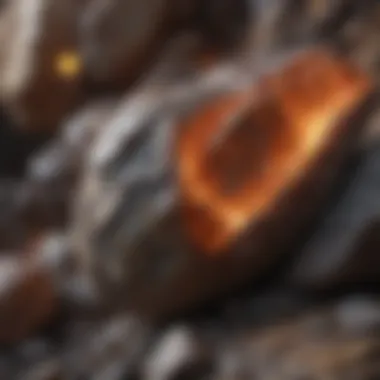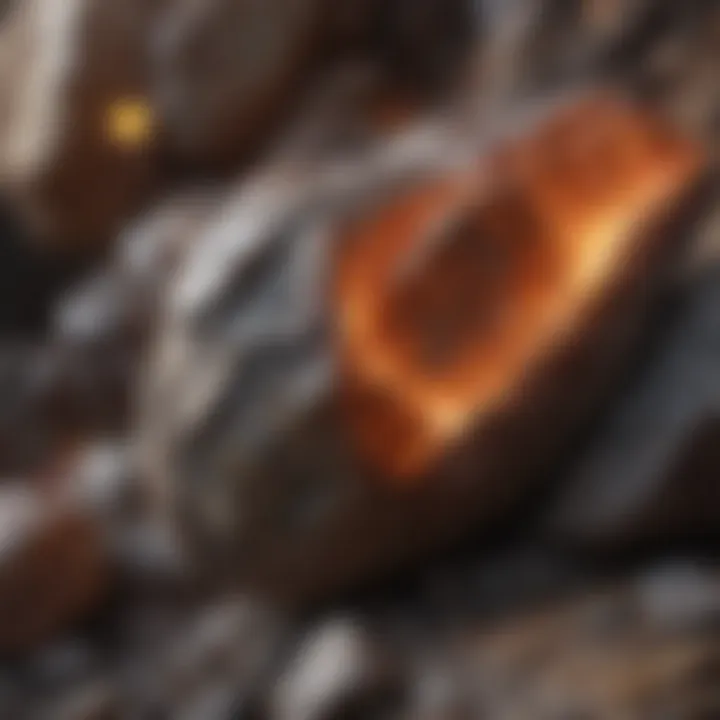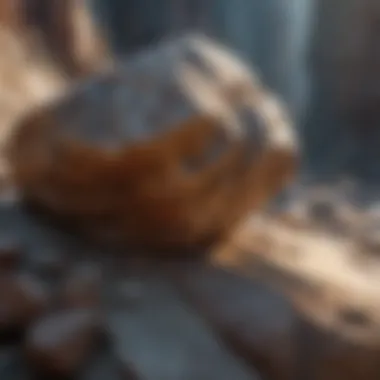Comprehensive Guide to Rock Identification Techniques


Intro
The study of rocks is more than just a hobby; it's an adventure into the heart of our planet. Rocks tell stories of geological processes that span millions of years, revealing Earth's past and present. Whether you're just starting out or already knee-deep in your collection, understanding how to identify different types of rocks can lead to rewarding discoveries. This guide is designed as a thorough roadmap, steering both novices and seasoned collectors through the complex landscape of rock identification.
Featured Collectible of the Month
Overview
For this month's featured collectible, let's shine a light on the stunning Amethyst Geode. Amethyst, famed for its deep purple hues, is not just pleasing to the eye, but also steeped in cultural significance throughout history. Emerging from volcanic rocks, these geodes form when mineral-rich liquids percolate into cavities, gradually crystallizing into sparkling formations. Many collectors find them not only beautiful but also thought-provoking due to the natural processes involved in their creation.
Historical Significance
Historically, amethyst has been revered across various cultures. The ancient Egyptians used it for amulets, believing it would protect against intoxication. Meanwhile, in medieval Europe, it was linked to royalty and the divine, often crafted into ornate jewelry. Today, it isn't merely a collector's item; it symbolizes clarity and calmness in the modern world.
Identification Techniques
Identifying rocks isn't just about guessing; it's a scientific endeavor that involves keen observation and understanding of various characteristics.
Visual Characteristics
When you first encounter a rock, your eyes provide essential clues. Look for attributes such as:
- Color: Different minerals yield a variety of colors.
- Luster: Is it shiny or dull? This can help decipher its mineral content.
- Texture: Is the surface smooth, coarse, or grainy? This may indicate its formation process.
- Grain Size: Are the grains large or small? This can hint at whether the rock is igneous, sedimentary, or metamorphic.
Resources for Identification
To aid your quest, tap into a range of resources:
- Books: "Rocks and Minerals" by the American Museum of Natural History is a reliable starting point.
- Websites: Check out Britannica, where you can find well-rounded articles on the subject.
- Community Forums: Websites like Reddit host dedicated communities where enthusiasts post images of their collections and request help in identifying them.
Rocks may seem timeless, yet within each grain lies a tale waiting to be unearthed.
Foreword to Rock Identification
Understanding rock identification goes beyond recognizing pretty stones. It is an essential skill that lays the foundation for any geology enthusiast or avid collector. Knowing how to identify different types of rocks not only broadens one’s knowledge of natural history but also enhances appreciation for Earth’s processes. When we talk about rock identification, we’re really discussing a window into the planet's past. Each rock tells a story—its formation, the environment in which it was created, and the conditions that have altered it over millennia.
The importance of rock identification cannot be overstated for those engaged in either casual or serious collection. Identifying a rock correctly informs decisions about its care, storage, and potential educational value. Moreover, it helps collectors avoid misunderstandings that may arise from mislabeling or misidentification. For example, confusing a piece of granite with gabbro could lead to costly mistakes in appreciating their distinct features and origins.
Additionally, rock identification has practical implications in various fields such as construction, archaeology, and mineralogy. Understanding rock types can aid engineers in selecting appropriate materials for building, while archaeologists may determine the age of artifacts by knowing where certain rocks originate. In essence, rock identification is a skill that proves useful not only for hobbyists but also for professionals navigating the complexities of geological materials.
Equipping oneself with the ability to identify rocks fosters a deeper connection with the environment. It encourages curiosity about the world, urging individuals to explore geological formations, visit quarries, or hike through national parks. Those who grasp the intricacies of rock identification often find themselves engaged in lively discussions, exchanging insights with fellow enthusiasts, which adds layers of social interaction to the hobby.
Importance of Rock Identification
The significance of rock identification extends into various domains, impacting not only personal collecting practices but also professional fields. Understanding and identifying rocks enhances one's ability to appreciate geological diversity and history. For instance, it encourages geological mapping—an essential aspect of understanding Earth’s structure. Whether one is plying through the rocks of a local park or trekking across international terrains, knowing what one is looking at enriches the experience.
In educational contexts, students learn about the rock cycle and Earth’s processes in more vivid detail by identifying and collecting samples. This hands-on experience solidifies theoretical knowledge and fosters a love for geology that could potentially lead to careers in science or conservation efforts.
Moreover, identifying rocks correctly aids in preservation efforts. For collectors who seek to protect rare or endangered rock types, accurate identification is crucial. Without it, valuable specimens might be misplaced or poorly cared for, leading to their deterioration.
In summary, rock identification is not simply about classification; it embodies a pursuit of knowledge—valuable both personally and professionally. Understanding and correctly identifying rocks enable enthusiasts to appreciate the nuances of geology, ultimately connecting us more profoundly with our planet.
Overview of Different Rock Types
To navigate the world of rock identification, one must first understand the primary classifications: igneous, sedimentary, and metamorphic rocks. Each of these categories rises from distinct processes and exhibits unique characteristics:
- Igneous Rocks: Formed from cooled molten rock, these can occur beneath the Earth's surface (intrusive) or from lava that erupts (extrusive). Examples include granite and basalt, both of which vary in grain size and mineral composition.
- Sedimentary Rocks: Created through the accumulation of sediment, often from erosion, these rocks showcase layers. Fossils are commonly found within sedimentary rocks, further enriching their story. Notable examples are limestone and sandstone.
- Metamorphic Rocks: Born from existing rocks transformed by temperature and pressure, metamorphic rocks reveal how geological processes reshape materials. Schist and gneiss serve as prime examples.
Having a clear understanding of these rock types lays the groundwork for anyone serious about rock identification. By familiarizing oneself with these classifications, collectors can better identify, categorize, and appreciate the rocks they encounter in nature.
Understanding Rock Types
Understanding rock types serves as the foundation of rock identification, as it lays down the bedrock from which collectors and enthusiasts can build their knowledge. Each rock type not only tells a story about the Earth's processes but also gives insight into its history and composition. In this section, we delve into the three primary rock types: igneous, sedimentary, and metamorphic. Grasping the nuances of these rocks is crucial for anyone aiming to truly appreciate the geological wonders that surround us.
Igneous Rocks
Formation Process
Igneous rocks are formed when molten rock, known as magma, cools and solidifies. This can occur beneath the Earth's surface, creating intrusive igneous rocks, or on the surface following a volcanic eruption, giving rise to extrusive igneous rocks. The key characteristic here is the rapid cooling at the surface, which often results in fine-grained textures, as seen in basalt. The benefit of understanding this process is significant; it not only helps in identifying various igneous rocks but also enables collectors to appreciate the dynamic activity that shapes our planet. Moreover, it's fascinating to consider how the cooling rate can produce a range of textures from glassy obsidian to coarse-grained granite.
Characteristics
When it comes to igneous rocks, textural features are paramount. For instance, they may appear glassy, like obsidian, or possess visible crystals, such as granite. A standout characteristic is the mineral composition, which typically includes quartz, feldspar, and various other minerals that determine color and hardness. Understanding these characteristics is beneficial, as it helps enthusiasts distinguish between different types based on visual cues alone. The diverse textures and colors of igneous rocks provide a wealth of information about their formation and the environment in which they cooled.
Common Examples
Common examples of igneous rocks include granite, basalt, and pumice. Granite typically features a coarse-grained texture, rich in quartz and feldspar, making it a favorite among builders and rock hounds alike. Basalt, on the other hand, is often darker and finer-grained, commonly forming from lava flows. Recognizing these examples can be quite advantageous for hobbyists because it allows for quicker identification during fieldwork. Each type offers unique features that reflect the conditions under which they formed, giving deeper insight into volcanic activities.
Sedimentary Rocks
Formation Process
Sedimentary rocks form through the accumulation and consolidation of mineral and organic particles over time. This process includes weathering, erosion, deposition, and lithification. The core aspect of this formation is that it records the history of the Earth's surface. Sedimentary rocks can contain fossils, presenting a snapshot of past life. This method of formation is valuable for rock identification because it reveals information about the environment where the sediments were deposited, such as riverbeds or ocean floors.


Characteristics
Sedimentary rocks are often layered, a direct indicator of their formation process. They can vary from soft and crumbly, like sandstone, to hard and dense, like limestone. A key feature is the presence of fossils, which can add context to the age of the rock and the life forms that existed in that era. By examining these characteristics, collectors can glean not just identifying traits but also the environmental and biological history of a rock, which enriches the entire identification experience.
Common Examples
In the realm of sedimentary rocks, sandstone, limestone, and shale are frequently encountered. Sandstone, composed mainly of sand-sized mineral particles, can indicate past environments like deserts or river deltas. Limestone often forms from accumulated biological debris, providing insights into ancient marine settings. The unique virtues of these rocks lie in the stories they tell, making them treasures for any enthusiast aiming to understand our planet’s history.
Metamorphic Rocks
Formation Process
Metamorphic rocks originate from existing igneous, sedimentary, or other metamorphic rocks that undergo changes due to heat, pressure, or chemically active fluids. The metamorphism process alters their mineral composition and texture without melting them. A significant aspect of this transformation is that it can lead to the development of foliation, which manifests as layered or banded structures. Understanding this process is crucial because it helps collectors recognize altered rocks and grasp the geological forces at play in their formation.
Characteristics
The unique characteristics of metamorphic rocks often include a distinct foliation or banding, derived from the alignment of minerals under pressure. This can result in visually striking formations like schist or gneiss. Other examples, such as marble, display a crystalline texture. Recognizing these features can aid enthusiasts in identifying the specific kinds of metamorphic rocks during their explorations, adding depth to the collecting experience.
Common Examples
Common metamorphic rocks include marble and schist. Marble, formed from limestone, exhibits a stunning array of colors and patterns, making it a popular choice for sculptors and architects. Schist features prominent layers and tends to have shiny, reflective minerals like mica. Being able to identify these common examples empowers collectors, as it connects them to the natural processes shaping the Earth.
Understanding rock types is not just about identification; it’s about forming connections with the past and grasping the processes that have sculpted our planet. By diving deep into igneous, sedimentary, and metamorphic rocks, enthusiasts equip themselves with the knowledge necessary for a richer appreciation of geology’s myriad wonders.
Tools for Rock Identification
When one embarks on the journey of rock identification, having the right tools at hand is essential. These tools not only facilitate a better understanding of different rock types but also enhance the enjoyment of the activity. Whether you are a weekend enthusiast or a seasoned collector, utilizing the appropriate instruments can significantly improve your identification process. Let's delve into the basic and advanced tools that can assist you in your adventures.
Basic Tools
Hand Lens
A hand lens, often referred to as a magnifying glass, is an indispensable tool for anyone serious about rock identification. It allows you to closely examine the texture, mineral composition, and any unique features of the rock surface. One of the main characteristics that make a hand lens appealing is its portability; it can easily fit into your pocket or a small bag, which is handy during field trips.
The ability to magnify up to ten times makes it easier to spot details invisible to the naked eye. However, one thing to consider is that the quality of hand lenses varies, and opting for a well-made one can make a world of difference in clarity and ease of use.
Field Guide
A reliable field guide serves as a roadmap for rock explorers. These guides often present a wealth of information on various rock types, including their formation, characteristics, and even geographical distributions. The key aspect that makes a field guide so beneficial is that it is often specifically tailored to local geology. This localized approach enhances your understanding and accuracy in identifying rocks in your area.
A field guide's unique feature is its visual catalog, where you can find images and descriptions of rocks at a glance. However, it’s essential to note that not every guide contains the most current information, so keeping an updated edition handy may prove advantageous.
Hammer
No rock collector’s toolkit is complete without a sturdy hammer. A rock hammer serves two main uses: breaking apart rocks for a closer inspection of their internal structure and giving precision strikes to loosen rocks from their resting places. One prominent characteristic of a good rock hammer is its dual-ended design, often featuring a flat side for pounding and a pointed pick for prying.
The durability of a well-designed hammer makes it a popular choice among collectors, as it can withstand the demands of outdoor use. However, it’s worth remembering that safety should always come first; wearing safety goggles is crucial to protect yourself from flying rock particles.
Advanced Equipment
Geological Hammer
The geological hammer is like the big brother of the traditional rock hammer. Its specialized design caters specifically to geological needs, allowing for more efficient breaking of solid rock and sediment. The key feature of a geological hammer is its balanced weight distribution, which enhances precision and efficacy during use.
This tool is particularly beneficial for serious collectors who often find themselves in tougher geological terrains where conventional hammers might fall short. Its unique design facilitates a more controlled strike, but be prepared for its heavier weight compared to standard hammers.
Rock Saw
When it comes to dissecting rocks into thinner slices for detailed study, a rock saw comes into play. This equipment allows collectors and geologists to create polished sections of samples, which can aid in examining internal features and layering. The key characteristic of a rock saw is its diamond blade, which provides the cutting power needed to tackle even the hardest materials.
The advantage of using a rock saw lies in its capacity to yield precise and clean cuts, making it easier to analyze mineral compositions. Conversely, rock saws can be quite an investment, both in terms of price and maintenance, so it’s generally recommended for serious enthusiasts.
Microscope
A microscope brings your rock collection to a whole new level. This advanced tool allows for microscopic examination of rock samples, highlighting features such as mineral grains and textures that would otherwise go unnoticed. The unique characteristic of a microscope, especially a petrographic one, is its ability to enable polarized light to examine samples in-depth.
Using a microscope can truly transform how you understand your collections, revealing intricate details about a specimen's composition and history. However, it does require a higher level of technical know-how and can be cumbersome to set up for field use.
In summary, the right set of tools can greatly enhance your rock identification experience, whether you are starting out or looking to deepen your expertise. From hand lenses to microscopes, each tool serves its purpose in aiding both observation and understanding.
Techniques for Identifying Rocks
When it comes to understanding the world of rocks, mastering the techniques for identifiyng them is crucial. These methods enable collectors and enthusiasts to distinguish between the myriad of rock types, ensuring accurate identification, whether for academic, practical, or recreational purposes. The techniques span from assessing simple physical characteristics to conducting chemical tests, each having its own importance and applications. By employing these strategies, individuals can gain deeper insights into the geological history and composition of the rocks they encounter.
Physical Characteristics
Physical characteristics serve as the initial line of defense in rock identification. They provide an accessible means for amateurs and professionals alike to make educated guesses about a rock's composition and origin. Observing aspects such as color, texture, and weight can often reveal essential information, creating a more conclusive path toward reliable identification.
Color


Color, often the first attribute that catches the eye, is more than just a superficial feature. It can provide immediate clues to the mineral composition of a rock. For instance, the vibrant red hue of iron-rich rocks, like hematite, suggests oxidation. However, relying solely on color can be tricky, as the same rock type can exhibit a variety of shades depending on weathering and environmental conditions.
A key characteristic of color is its variability; it can signal a rock's mineral makeup, but it also hinges on factors like lighting and surface texture. In the context of this article, understanding color can guide enthusiasts in their identification journey, but it shouldn’t be the sole determinant. Many experts recommend using color as a guideline while looking for other identifying factors.
Texture
Texture pertains to the feel and appearance of a rock's surface. It encompasses aspects like grain size, whether the surface is smooth or rough, and the crystalline nature of the rock. For example, igneous rocks like granite typically display a coarse texture due to their large mineral grains, while basalt exhibits a finer texture due to rapid cooling.
Texture is beneficial for identification since it often correlates with the rock's formation process. However, there’s a caveat: the same rock can have different textures based on environmental factors like cooling rate or pressure. In rock classification, texture is a unifying characteristic that brings valuable context to physical observations.
Weight
Weight can also play a significant role in rock identification, particularly when it comes to distinguishing between light and heavy specimens. For example, rocks rich in minerals like basalt tend to be heavier than those composed primarily of sandstone. Understanding weight distribution can help collectors gauge the rock's mineral density as well.
However, one must be cautious with weight as a standalone identifier. Rock size can notably affect weight perceptions; thus, dimensional assessment may be as essential as tactile evaluation. Ultimately, recognizing these aspects can add another layer of depth to one’s identification skills.
Chemical Tests
Chemical tests add a new dimension to rock identification, often revealing insights that physical characteristics can’t provide. These methods usually require some basic tools but can prove invaluable for confirming or refuting initial observations. The acid test and hardness test are two commonly employed methods that can lead to more definitive classifications.
Acid Test
The acid test is used primarily to determine the presence of calcite in a rock. When a drop of hydrochloric acid is applied, calcite reacts actively, effervescing and producing carbon dioxide bubbles. This reaction can be a dead giveaway for limestone or marble, which are both rich in calcite. Despite its straightforwardness, the acid test has its drawbacks. Not all rocks react similarly; for example, rocks containing other carbonates can give similar results, leading to potential confusion. Nevertheless, the acid test remains a staple for beginners looking to confirm their findings.
Hardness Test
The hardness test categorizes rocks based on their resistance to scratching, often utilizing the Mohs scale. This scale ranges from talc (softest) to diamond (hardest), allowing users to classify rocks based on their mineral composition. A rock’s hardness can offer clues about what minerals are present and how they've been altered over time.
One distinct advantage of the hardness test is its relative simplicity; a few tools like a fingernail, penny, or glass can assist in determining hardness levels. However, it’s worth noting that some rocks may display varying hardness throughout, complicating results. Thus, while highly effective, it should be combined with other identification techniques for reliability.
Geological Context
Understanding geological context is paramount for accurate rock identification. Knowing where a rock was found often sheds light on its formation process and provides essential clues needed to decipher its overall characteristics.
Locational Factors
Locational factors include elements like the geological maps and specific regions where certain rock types are prevalent. For instance, igneous rocks may be abundant near volcanic formations, while sedimentary rocks are typically found in sediment-rich environments like riverbeds or ocean floors. By recognizing these patterns, rock hounds can narrow down their identification process effectively.
Highlighting locational characteristics helps enthusiasts understand not just what kind of rock they have, but also the history behind its formation. Additionally, this geographic insight contributes to a larger understanding of Earth’s geological processes, making it a crucial aspect of identification.
Associated Minerals
Associated minerals provide additional context to the identification process. For example, finding quartz alongside a granite rock can confirm its identity, as these minerals often occur together due to their shared formation processes.
The advantage of examining associated minerals lies in their capability to strengthen identification claims. They can firmly tie a rock to specific environments or geological settings, thus clarifying muddled identifications. However, misjudging associations can lead to misidentifications, so careful analysis always remains necessary.
Common Challenges in Rock Identification
Rock identification can be as intricate as deciphering a code from an ancient civilization. For collectors and enthusiasts, understanding the challenges that come with identifying rocks is just as critical as knowing the types themselves. Misidentification may lead to a skewed understanding of geological history, misallocated resources, and even compromised safety in fieldwork. Furthermore, with numerous rocks sharing visual features, one ounce of diligence is worth a pound of cure.
The essence of navigating these challenges lies in effective tools, well-honed techniques, and a keen eye. Recognizing these pitfalls ensures a higher accuracy in identification, enhancing the collector’s experience and growing their knowledge base.
Misidentification Issues
Misidentification can stem from several aspects: visual similarities, insufficient knowledge, and even hasty conclusions. Many enthusiasts may encounter commonly confused rocks like granite and rhyolite. They can appear almost indistinguishable at first glance, yet their properties diverge significantly. It’s imperative to not overlook essential features such as texture and mineral composition.
Moreover, the learning curve can be steep for newcomers who often mistake sedimentary rocks like sandstone for more complex metamorphic varieties. A deeper understanding of these distinctions doesn't just foster better identification skills; it nurtures a richer appreciation for Earth's layers and processes.
To mitigate these misidentification issues, collectors can adhere to a few strategies:
- Study Morphology: Familiarize oneself with variations in size, shape, and form.
- Field Guides: Use reliable field guides that delve into nuanced details about rocks’ characteristics and origins.
- Peer Engagement: Don’t hesitate to ask seasoned collectors or geologists for insights; a second opinion can shine a light on overlooked details.
"Rocks tell stories of the earth; it’s our job to listen carefully."
Dealing with Altered Rocks
Altered rocks, particularly those that have undergone significant transformations due to heat, pressure, or chemical action, pose unique challenges. Metamorphic rocks, for example, arise from the metamorphosis of either igneous or sedimentary types, making identification a complex endeavor. Just think of schist, which can morph from shale under varying conditions, leading to confusion during identification.
Additionally, some rocks may display characteristics that hint at previous alterations. Recognizing that a rock's exterior might not tell the full story requires a closer examination. Techniques such as thin section microscopy can reveal internal structures and alterations invisible to the naked eye. Utilizing varying test methods, like examining the rock’s response to acid, can also provide clues to its history.
For enthusiasts facing altered rocks, consider these approaches:
- Documentation: Keep good records of observed transformations—photos, notes, and environment samples can prove invaluable.
- Chemical Testing: Conduct tests, such as hardness or effervescence with acid, to analyze mineral composition.
- Continuous Learning: Engage in forums and communities to learn from shared experiences. For example, platforms like Reddit have vast discussions about common confusion regarding altered minerals.
By adopting an inquisitive mindset, collectors stand to gain immense insights regardless of the obstacles presented by misidentified or altered rocks.
Field Collecting Strategies
Field collecting strategies are vital in the realm of rock identification. Whether someone is a seasoned geologist or just a weekend adventurer, knowing how to efficiently and effectively gather rock specimens can significantly enhance their collection and overall knowledge. Effective field collecting techniques can help ensure that one captures high-quality samples and guarantees sustainability in collecting practices.


Choosing Locations
Choosing the right location for rock collecting can be as tricky as finding a needle in a haystack. The location can dictate the types of rocks one may encounter, which makes investing time in site selection worthwhile.
Geological Maps
Geological maps serve as the compass for rock collectors. They provide a detailed layout of different geological formations within an area. The charm of geological maps lies in their ability to show various rock types and the age of those formations.
- Key Characteristic: The layers of color and texture on a geological map highlight distinct geological features. This can lead to discovering unique rock types not found in more accessible locations.
- Unique Feature: They often reveal areas of interest, like faults or folds, which might result in rare mineral deposits.
- Advantages: Utilizing these maps can save a great deal of time when scouting for locations.
- Disadvantages: Sometimes, the maps can be outdated or not accurately reflect current conditions, especially after weather events.
Access and Permissions
When it comes to field collecting, knowing where to go is just half the battle; permissions play a crucial role. Many areas require permits, while others might have restrictions to protect the environment.
- Key Characteristic: Access points can vary wildly, from public lands to private property, which makes understanding these a priority before embarking on a collecting adventure.
- Unique Feature: It’s essential to engage with landowners or park services that may guide you about the local rules concerning rock collecting.
- Advantages: Gaining proper access helps not only in building relationships with local authorities but also encourages sustainable practices.
- Disadvantages: The process can entail red tape or bureaucratic delays which can deter some would-be rock enthusiasts from their collecting plans.
Proper Collection Techniques
Once the right locations have been identified, the next step is to employ the right collection techniques. How one collects rocks could significantly impact the integrity of the specimens.
Preservation Methods
Preservation methods are essential for maintaining the quality of collected rocks. Improper handling can easily lead to chips, cracks, or other harm.
- Key Characteristic: Using the right storage materials, such as bubble wrap or padded boxes, can make a world of difference.
- Unique Feature: Each rock type may call for specific preservation techniques – for instance, softer rocks may require more care than harder ones.
- Advantages: Well-preserved specimens can command attention and more appreciation from fellow collectors or at future exhibits.
- Disadvantages: The methods may sometimes be labor-intensive and may require extra resources, which could be a barrier for casual hobbyists.
Documentation Practices
Documenting findings goes hand in hand with effective collecting techniques. Without proper documentation, a rock's story might be lost forever.
- Key Characteristic: Each specimen should be recorded with details like location, date of collection, and any notable features.
- Unique Feature: A well-kept logbook can provide context for all your findings and becomes a treasure in its own right.
- Advantages: Documentation enhances the educational value of the collection and aids in future identification and appreciation.
- Disadvantages: It demands time and discipline to keep track which may deter some collectors from full implementation of this practice.
In rock collecting, every detail counts. Keeping a log of your findings can turn a simple collection into a rich narrative.
Field collecting, if done with care, can offer exciting learning opportunities and greatly enrich one’s rock identification journey.
Maintaining a Rock Collection
Maintaining a rock collection is not just about showcasing beautiful specimens; it's an engaging way to explore geology and understand the Earth's history. For enthusiasts, a well-kept collection offers a tangible connection to nature, a reminder of places visited, and a way to encapsulate experiences and stories. Proper care of each rock enhances its beauty and longevity, ensuring that these pieces of Earth remain as informative and visually appealing as the day they were collected.
Storage Solutions
Display Cases
Display cases are essential for any serious rock collector. These transparent containers protect specimens from dust and damage, while also giving collectors the chance to showcase their favorite pieces. The key characteristic of a display case is its ability to provide visibility; you can admire your collection while keeping it safe from external factors.
One unique feature of display cases is the option of adjustable shelving, which allows for customization to fit various sizes and types of rocks. This is particularly useful when accommodating unusually shaped specimens or larger geodes. However, while they offer excellent protection, display cases can sometimes limit airflow, which necessitates regular checks to prevent humidity buildup.
Labels and Tags
Labels and tags are crucial for documenting the details of each specimen in your rock collection. By identifying the rock type, location, and date of collection, you're providing essential information that enriches your collection's narrative. The key characteristic of labels is that they enhance the educational aspect of a collection, making it easier for others – or even yourself at a later date – to appreciate the significance of each piece.
An important aspect of labels is their durability. Options include weather-resistant tags that stand the test of time, ensuring longevity, and avoiding confusion down the line. However, it is important to keep in mind that poorly attached labels can fall off or get damaged, which leads to lost information and can diminish the overall value of the collection.
Cleaning and Care
Cleaning and care of your rocks is vital to ensure they remain as beautiful as the day they were found. Any collector worth their salt knows that dirt and grime can obscure unique features, thereby undervaluing their specimen. The key characteristic of cleaning techniques is that they must be gentle; aggressive cleaning can result in scratches or damage, especially to delicate minerals.
Some effective cleaning techniques involve using soft brushes and lukewarm water to remove accumulated dust and debris. Soap can be used in some cases, but it’s crucial to research individual rock types, as certain minerals may react negatively. Regular cleaning not only maintains aesthetics but also helps in identifying any potential issues, like cracks or mineral deposits that could affect the integrity of a rock.
Avoiding Damage
Avoiding damage to your cherished collection is equally important as cleaning. Each rock has its own level of hardness and sensitivity to environmental factors, which must be understood to protect them appropriately. The key characteristic of avoiding damage lies in understanding the specific needs of your individual specimens.
For example, softer minerals can chip easily if handled too roughly; using proper tools and techniques helps minimize risks. Storing your collection in a stable environment away from direct sunlight and temperature fluctuations also plays a crucial role. The unique aspect of this approach is that you can preserve the original beauty of your rocks without compromising on display or accessibility.
The End
When it comes to the world of rock identification, reaching a conclusion is not merely the end of our journey but a reflection of all the knowledge we've gathered along the way. Understanding the processes and nuances involved in identifying rocks is essential for any enthusiast, whether you're just starting out or have been collecting for years.
In this article, we've delved into various aspects that contribute to effective rock identification. The detailed sections covered the importance of recognizing different types of rocks, the tools needed, and practical techniques that can be employed in the field. Equipping oneself with this knowledge not only enriches the experience of collecting but also enhances one's appreciation for geology as a whole.
Summary of Key Points
Breaking down what we've learned, here are the pivotal elements that should remain at the forefront:
- Types of Rocks: Understanding igneous, sedimentary, and metamorphic rocks, including their formation and characteristics, is critical for correct identification.
- Identification Tools: Knowing how to utilize tools like a hand lens or advanced equipment like a microscope can significantly improve your accuracy.
- Techniques: Observing physical characteristics and conducting chemical tests serve as the backbone of the identification process.
- Challenges: Recognizing potential misidentification or altered rocks cannot be understated; it's a frequent obstacle for collectors.
- Field Strategies: Smart collection strategies, such as choosing the right locations and proper documentation, ensure a successful outing.
Encouragement for Continued Learning
As we wrap up, it's crucial to encourage ongoing exploration. Geology is a broad field, and there's always something new to discover. Whether it's enhancing your skills through hands-on experience or diving into specialized books and resources, continued education will serve you well.
Joining online communities like those found on Reddit or engaging with fellow collectors on Facebook can open doors to discussions and insights that will further broaden your understanding.
Take the opportunity to explore beyond the surface and stay curious; the rocky road of geology is a path worth trotting. Investing time into expanding your knowledge will not only enhance your collection but will elevate your experience as a whole.
At the end of the day, every rock tells a story, and it's up to you, the collector, to uncover its secrets.



